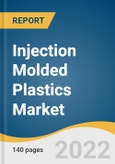The global injection molded plastics market size is anticipated to reach USD 423.7 billion by 2030, registering a CAGR of 4.2% in the forecast period. Growing demand from key applications including automotive, packaging, and construction, particularly in Brazil, Russia, India, China, and South Africa (BRICS) nations, is likely to drive the growth. The high-growth regions, such as Middle East and Asia Pacific, have witnessed a surge in capacity addition over the last few years. An increasing number of plastic injection molding companies in China on account of low manufacturing costs and ample availability of skilled labor is anticipated to benefit the regional market.
Major foreign companies are increasing their production capabilities in the region owing to the growing demand for plastic products. Government support in the form of tax benefits and financial incentives in China and India to increase the FDI flow has helped develop the market for plastics in these countries.In packaging applications, High-density Polyethylene (HDPE) is extensively used in thin wall injection molding. Growing demand for food, bin liners, and thing gauge bags is further anticipated to drive the segment growth over the forecast period. Rising penetration of injection-molded HDPE in shipping containers, industrial pails, and houseware applications is anticipated to further drive its demand over the forecast period.
The COVID-19 pandemic has affected the revenue generation of the companies operating in the market owing to the halt or slowdown in the production facilities. Thus, the companies are focusing on stepping up their resources and production capabilities to help in the fight against the pandemic. For instance, G&C products, a U.S.-based plastic injection mold making company that produces plastic products for the fishing and medical industry, started the production of Personal Protective Equipment (PPE), such as face shields and face masks.
This product will be delivered within 1-3 business days.
Major foreign companies are increasing their production capabilities in the region owing to the growing demand for plastic products. Government support in the form of tax benefits and financial incentives in China and India to increase the FDI flow has helped develop the market for plastics in these countries.In packaging applications, High-density Polyethylene (HDPE) is extensively used in thin wall injection molding. Growing demand for food, bin liners, and thing gauge bags is further anticipated to drive the segment growth over the forecast period. Rising penetration of injection-molded HDPE in shipping containers, industrial pails, and houseware applications is anticipated to further drive its demand over the forecast period.
The COVID-19 pandemic has affected the revenue generation of the companies operating in the market owing to the halt or slowdown in the production facilities. Thus, the companies are focusing on stepping up their resources and production capabilities to help in the fight against the pandemic. For instance, G&C products, a U.S.-based plastic injection mold making company that produces plastic products for the fishing and medical industry, started the production of Personal Protective Equipment (PPE), such as face shields and face masks.
Injection Molded Plastics Market Report Highlights
- In terms of revenue, the product is estimated to witness high demand from the packaging industry in Asia Pacific over the forecast period.
- Growth of the electronics industry coupled with the cost-effectiveness of electrical appliances is projected to remain a key driving factor for the next eight years.
- The demand from the medical sector in North America is anticipated to be high from 2022 to 2030.
- Packaging was the prominent application segment in France and is expected to augment at a considerable CAGR over the forecast period.
This product will be delivered within 1-3 business days.
Table of Contents
Chapter 1. Methodology and Scope
Chapter 2. Executive Summary
Chapter 3. Injection Molded Plastics Market Variables, Trends, and Scope
Chapter 4. Injection Molded Plastics Market: Raw Material Estimates & Analysis
Chapter 5. Injection Molded Plastics Market: Application Estimates & Analysis
Chapter 6. Injection Molded Plastics Market: Regional Estimates & Analysis
Chapter 7. Competitive Landscape
Chapter 8. Company Profiles
Companies Mentioned
- Exxon Mobil Corp.
- BASF SE
- DuPont
- Dow Inc.
- Huntsman Corporation
- Eastman Chemical Company
- INEOS Group
- LyondellBasell Industries N.V.
- SABIC
- Magna International, Inc.
- International Automotive Components (IAC) Group
- Berry Global, Inc.
- Master Molded Products Corporation
- HTI Plastics Inc.
- Rutland Plastics
- AptarGroup, Inc.
- Lacks Enterprises, Inc.
- The Rodon Group
- Heppner Molds
Methodology

LOADING...
Table Information
| Report Attribute | Details |
|---|---|
| No. of Pages | 140 |
| Published | April 2022 |
| Forecast Period | 2022 - 2030 |
| Estimated Market Value ( USD | $ 303.7 Billion |
| Forecasted Market Value ( USD | $ 423.7 Billion |
| Compound Annual Growth Rate | 4.2% |
| Regions Covered | Global |
| No. of Companies Mentioned | 19 |









